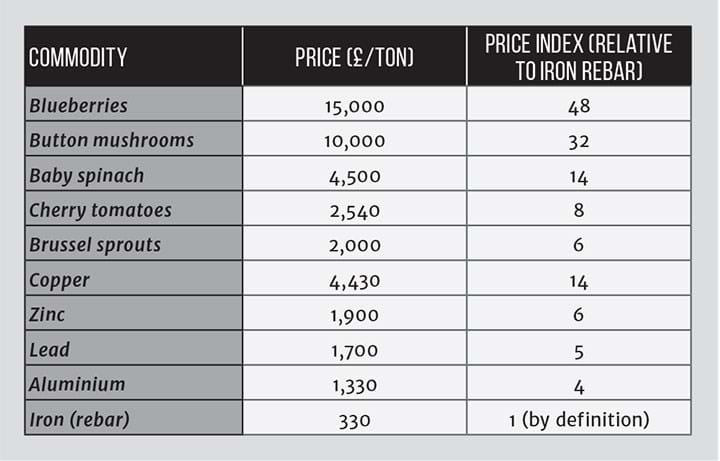Bulk Solids Handling: Perspective on a Professional Blind Spot

A topic often overlooked and misunderstood, Grant Wellwood looks at the prevalence of bulk solids handling and asks how can we get it right
QUESTION: What is the biggest industrial activity on the planet that can quickly and efficiently destroy value, careers, projects and even organisations?
Answer: Bulk solids handling (BSH).
Trite? Intellectually boring? Not relevant to me as a chemical engineer? Think again!
As chemical and process engineers, our primary purpose is to add value to materials through the building blocks of our profession – unit operations – which are usually found linked up in the form of value chains. Material flow through a value chain governs its commercial success and, given that the majority of everything we use or consume passes through a bulk phase during its lifecycle, bulk solids flow is very relevant.
It is estimated that >70% of everything we use or consume involves bulk solids handling somewhere in its lifecycle
While the science of bulk solids flow is established, it is not widely covered in undergraduate engineering courses, so most of us enter the workforce oblivious to this blind spot. How can we design and optimise value chains featuring bulk solids when we are blind to the science? The answer is that we cannot. As a direct consequence, most value chains featuring bulk solids go into service life with baked-in design errors manifesting as flow problems during commissioning that go on to plague the operation for its useful life. This destroys value and is a collective challenge for us engineers.
What are bulk solids?
Bulk solids are defined as materials (solids) that are handled without a count and in large volume. Everything we use or consume comprises raw materials that must be either grown or dug up and, in most cases, before we add enough value to warrant counting items, we need to handle bulk solids.
Surprising to some is the fact that BSH is the biggest industrial activity on the planet. It is estimated that >70% of everything we use or consume involves bulk solids handling somewhere in its lifecycle (Figure 1).
Bulk solids handling cuts across all sectors and while the precise volumes moved annually are incalculable, we can use coarse grain estimates to get some appreciation. Over a lifetime, the amount of bulk solids that needs to be moved to keep each of us in a modern lifestyle is of the order of 4,000–5,000 t. Urbanisation and resource quality decreases ensure the aggregated volume keeps increasing year-on-year, ensuring it remains the most dominant industrial activity.
Economies of scale
Referring back to the ‘grow it’ or ‘dig it up’ origins of common raw materials, it is an interesting exercise to compare the mining and agricultural sectors in terms of the prices their commodities attract.
The price for baby spinach, for example, is on-par with copper cathode. In the context of the processing and handling pathways involved many find this fact surprising, but the trend is consistent for most common metals (Table 1).

For most engineers who appreciate or live one of these mineral-metal production backstories, this is a massive difference in expectations. Based solely on the process and value chain “journeys” between a ton of reasonable-purity metal and a ton of tomatoes. How is this even remotely possible?
The Kennecott Utah Copper mine in Utah moves around 23,000 t of rock every hour of every day. This is 9,000 t of ore and 14,000 t of waste
The reason, of course, is the economies of scale for which the mining industry is famous. For example, the Kennecott Utah Copper mine in Utah moves around 23,000 t of rock every hour of every day. This is 9,000 t of ore and 14,000 t of waste.
Large unit operations that facilitate large operations are undoubtedly an engineering triumph, but without an efficient way to transfer the bulk solids from and through them, the price of the metal product would be significantly higher. The application of bulk solids science facilitates the economies of scale that keep the prices of metals low, and we all enjoy the benefit every day. However, before we start slapping each other on the collective backs, we need to consider how much value we are leaving on the table through naïve BSH designs.
Unit operations
As a profession, we are collectively fascinated by the process of increasing the value of raw materials through physical and/or chemical transformations, however when it comes to value chains featuring unit operations processing bulk solids, there are two additional considerations we need to be interested in:
- presentation of the particles to the transformative instruments/elements within; and
- supplying the feed and moving the derivatives to the battery limits.
Individual particle presentation
Our training has focussed us on the design/selection of unit operations in value chains and then optimising their transformational efficiency during their service life. We typically work at the macro scale and do not zoom into the level of presentation of individual particles. Given the nature of many transformations, the orientation of the particles presented often matters a great deal.
This “bulk solids science meets transformation within the unit operation” is a largely unexplored area with promise to make significant differences to the performance and productivity of many unit operations. My top tip for the future is the development of ‘functional BSH’.
Flow through the system
Our unit operation optimisation efforts are important, as they maximise the potential value-add of the chain, but there is another dimension to be considered. Potential is only realised in terms of revenue when there is flow, so revenue is not only a function of the cumulative value-adding steps in the value chain but is also a function of the effective flow rate through it. The full value of optimisation efforts cannot be realised without it.
The flow behaviour of liquids has been the subject of intense study by a star-studded cast of exceptional engineers and polymaths for over 450 years, but it wasn’t until the work of Andrew Jenike that the science underpinning the flow behaviour of bulk solids became well-established and accessible
It is logical when you see it laid out, yet it comes as a surprise to many (me included), as I was trained specifically to add value to material, and no one said anything about bulk solids ‘presentation’, ‘transfers’ or ‘flow’.
When we look at how revenue is generated, many of us are really in the business of flow, and as we will see, getting bulk solids to flow in a controlled manner takes conscious effort.
Professional blind spot
Process engineering is in essence a dynamic field where flow (particulate solids, liquids and/or gases) through the value chain underpins nearly everything we do, although for most of us the fact that bulk solids flow differently from liquids remains a blind spot.
The flow behaviour of liquids has been the subject of intense study by a star-studded cast of exceptional engineers and polymaths for over 450 years (Figure 2), but it wasn’t until the work of Andrew Jenike (1914–2003) that the science underpinning the flow behaviour of bulk solids became well-established and accessible.

So why, 50 years on does BSH remain an enigma to process engineers? Our profession is all about transformation and value add, and bulk solids flow does none of this (intentionally at least). Bulk material flow elements (bins, feeders, chutes etc) are not unit operations. Simply handling bulk solids does not increase its intrinsic value, and it’s often not considered technically challenging or important enough to dedicate your career to (unless you have been enlightened), which all manifests in the fact that it is not properly covered in undergraduate curriculum. So why do we have this disconnect between our education and such a common and, for many of us, a critical profession competency? Some reasons often cited include:
- bulk solids are perceived as being low-tech;
- bulk solids are usually complex and adaptive, hence not easy to define mathematically or in terms of their physical properties;
- experimentation is essential since a purely computational approach (as per the undergraduate treatment of liquid and gases), while the long-term goal, is unrealistic;
- characterisation of key performance parameters like flow function require specialised testing equipment, experienced technicians (compare to using a viscometer, for example) as well an appreciative holding-time to complete;
- bulk solids are more problematic (messy, heavy, awkward, etc) to deal with in a laboratory setting (see Table 2 for their difficult behaviours); and
- design methods are less developed and/or are maintained as trade secrets.
All-in-all these practical challenges tend to deter academics from entering the field themselves and/or teaching the science at undergraduate and postgraduate level.

How bulk solids flow differs from fluid flow
Having established that bulk solids flow is important for productivity and revenue in many process engineering value chains, what exactly are we talking about? Let’s start with the most familiar understanding of flow, that associated with liquids.
Bulk solids are usually complex and adaptive hence not easy to define mathematically or in terms of their physical properties
For all intents and purposes, flow behaviour of liquid is characterised by a single parameter – its viscosity, which is usually only a function of temperature. Once you know the temperature you know the viscosity, and thus you know the flow behaviour. Furthermore, there is no need to measure the viscosity of the fluid yourself. If you know the fluid and the temperature, you can easily look up its viscosity.
Sadly, this simple and familiar framework developed over the last 450 years does not apply to bulk solids.
The nature of bulk solids
Unlike fluids, the movement of bulk solids is controlled by friction (particle-particle, particle-surface); and every discrete element (from dust spec to boulder) in an unrefined (raw) solid feed is physically and chemically unique. Consequently, the flow properties change, often dramatically, depending on the complex interactions between particle size and distribution, moisture content and distribution, process history (time and manner), mineral composition, surface texture and condition as well as ambient conditions, just to name a few! Bulk solids are unique in that:
- they are not solid, although they can withstand some deformation;
- they are not liquids, although they can be made to flow and;
- they are not gases, although they can be compressed.
For these reasons the bulk solids form is often referred to as the fifth state of matter observable in everyday life: solid, liquid, gas, plasma and bulk solid.
As process engineers we are most interested in the controlled movement or ‘flowability’ of a bulk solid which is also a function of the design and general arrangement of the handling equipment and associated materials of construction. For example, ‘easy’ or free-flowing bulk solids placed in an unmatched piece of equipment can become difficult to handle; whereas material that appears hard to handle because it is sticky can flow reliably if the design is considered. When handling bulk solids, it’s always important to take a holistic or systems view because of the complex dependencies.
Recent Editions
Catch up on the latest news, views and jobs from The Chemical Engineer. Below are the four latest issues. View a wider selection of the archive from within the Magazine section of this site.




